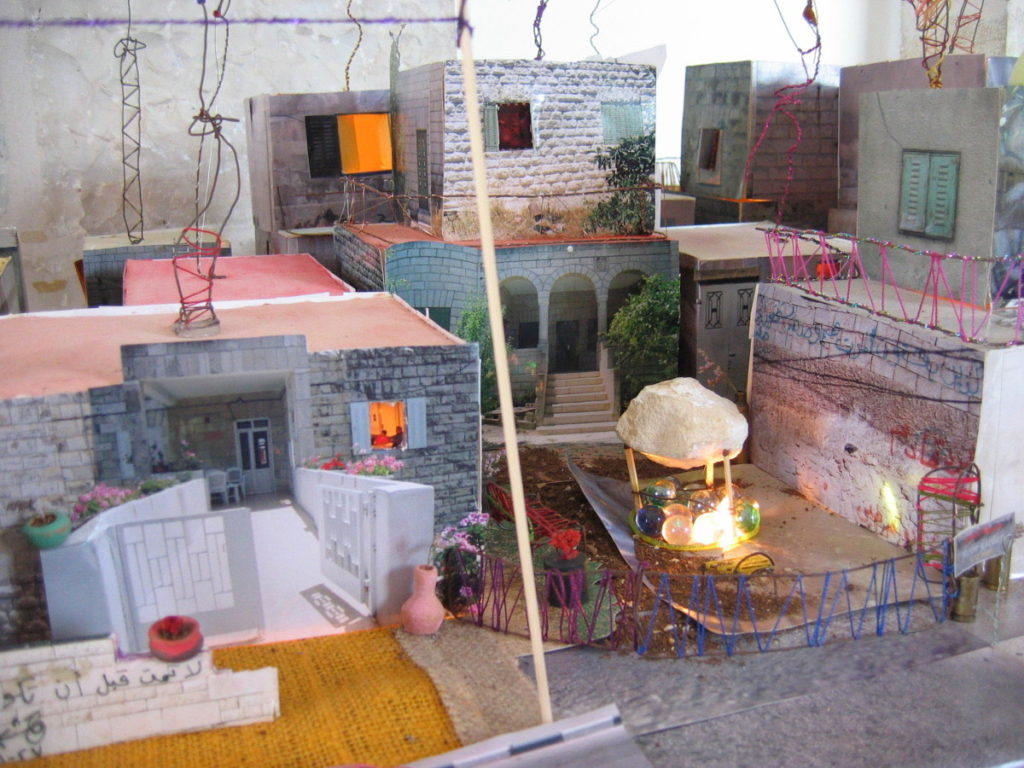By N.A. Mansour
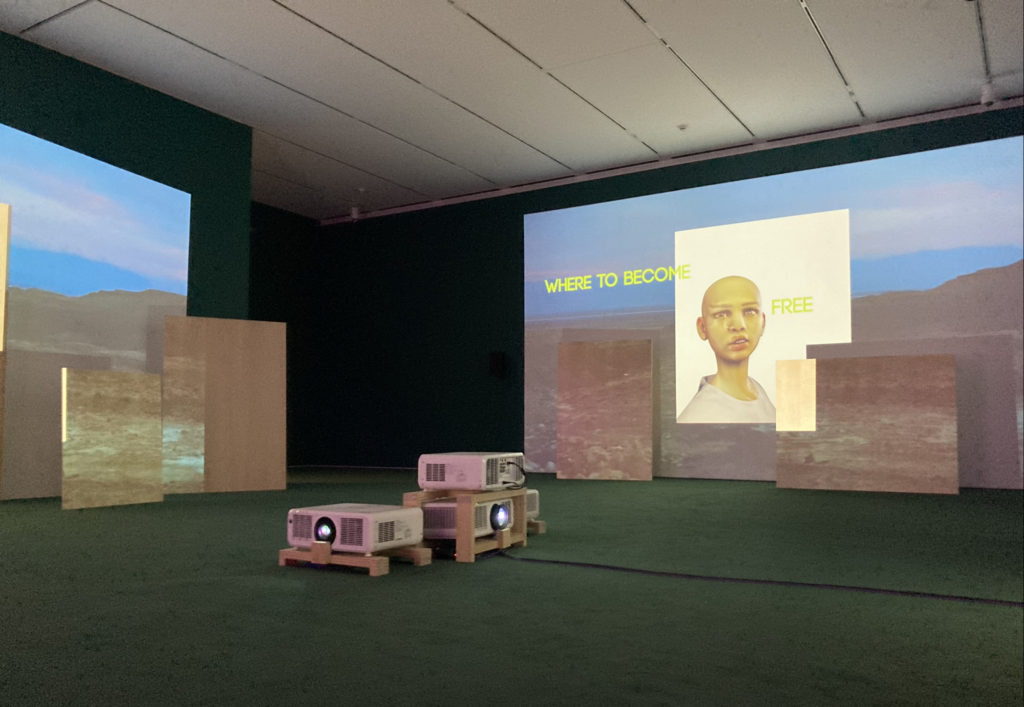
Maybe I just have to resign myself to the fact that some Palestinian art is not made for me, a Palestinian.
When Palestinian culture is given some representation at major institutions and major publications, my instinct is to support it, even though I know diversity, equity and inclusion policies are instrumentalized as corporate tools. I try to be optimistic.
I tried to be optimistic when I heard that the Art Institute of Chicago was running Palestinian artists Basel Abbas and Ruanne Abou-Rahme’s exhibition If only this mountain between us could be ground to dust, from July 31, 2021 until January 3, 2022. It’s one of the very few shows the Art Institute of Chicago has organized featuring contemporary artists from the Arabic-speaking world; it might even be the first, certainly the only in the last decade. The Art Institute’s permanent collection has a poor record when it comes to modern Arab artists, with only a handful representing the region, including Ghada Amer, Lalla Assia Essaydi, and Jacob El Hanani. Compare that to the dozens of Warhols perpetually on display.
My optimism is spurred by the art I adore. I think of Wafa Hourani, who exhibited his playful, bittersweet futuristic miniatures of Qalandia, a Palestinian refugee camp, in Qalandia itself first before taking them elsewhere, inviting the communities represented. They delighted in seeing their homes, albeit set in the future. Even in the grey concrete of the refugee camp, Hourani mimics the rhythm of everyday life by recalling the little touches of beauty residents carefully tuck into their lives.
But I find myself –by being optimistic– disappointed, roughly 50% of the time. I never vocalize it. But through my head propels the same internal conversation, running at double-speed because I know all of its beats: there is Palestinian art made for non-Palestinians. I can live with that, especially when Palestinian discourse needs to make it to the general public, not just for Palestinians’ sake and the sake of our liberation, but hopefully, for the liberation of all oppressed peoples. But then, sometimes, when looking at Palestinian art, I find myself wondering how necessary Palestinian art is if it imitates violence done by Israel to Palestinians? Is it essential to the Palestinian liberation movement, through the sheer power of representation?
If only this mountain is set in a dark room, consisting of two works of video art played back to back and projected onto overlapping wooden boards on the four sides of the carpeted exhibition room, in addition to a series of inkjet prints and a vinyl near the exhibition’s entrance, titled Don’t read poetics in these lines (2010–2021) and Once an artist, now just a tool (2021), respectively. One of the two video works, At those terrifying frontiers where the existence and disappearance of people fade into each other (2019-2021), more than any other piece in the show, is meant to shock the audience. The video features clips of digitally created avatars from news footage of the March of Great Return, an annual demonstration in Gaza which began in 2019 to protest the Israeli blockade. Where images of the protesters were incomplete — think someone’s face blocking another’s mouth or cheek — software was used to render that skin as scarred or maimed. The avatars switch in and out, as English text flicks across the screen, narrated out loud in a distorted Arabic translation. Behind the avatars, footage of the Palestinian landscape, separation walls, and the moon occasionally distract the eye from the yellow text flashing across the screen. I had a difficult time watching it.
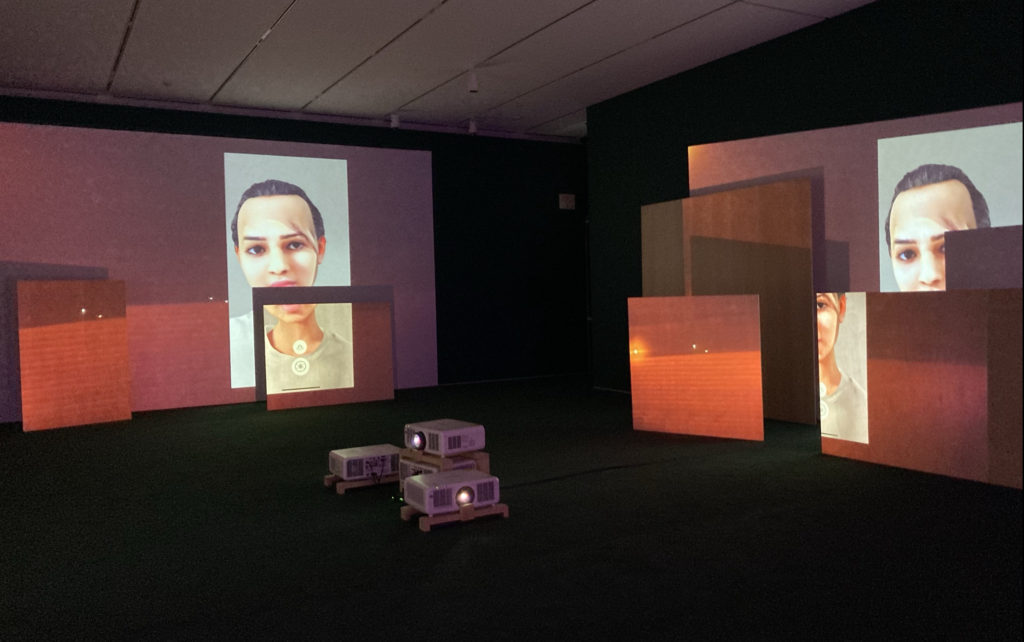
Scrolling through social media or watching the news is enough of an exercise in pain and PTSD for Palestinians. The occupation’s indiscriminate brutality towards Palestinians is well-documented: We are beaten by the occupation’s military and regularly humiliated in order to break our will. We also carry the burden of documenting brutality with our phones, social media accounts, journalism, and archives. As a Palestinian, I don’t need to see these actions mimicked in our art when much of our time is spent trying to get the outside world to notice our oppression in real time.
My quarrel is not with the underlying theme of At those terrifying frontiers. The Palestinian experience encompasses exile and dehumanization, and that will find its way into our art, along with our joy and our banalities. But, At those terrifying frontiers immediately alienated me. As I rewatched it back to back with the other work of video art, Oh shining star testify (2019), I could feel myself going to that deep dark well where my memories of violence live while also, revisiting a slightly newer reflex that’s emerged in the last decade: this inability to look away from blue screens while watching genocide play out on social media feeds. I had read the label on the wall before sitting on the floor to watch the video art: I knew it had been the artists who had altered the videos, although most Palestinians know that Palestinians were attacked by the Israeli military during the Great March of Return. I tried to understand why figures distinctly identified as Palestinians were portrayed as maimed – when they were actually unmaimed in the original videos; perhaps to disrupt the museumgoer’s experience. The piece reproduces that same violence wielded against Palestinians by the Israeli government and military, but this time allegedly in the name of pro-Palestinian advocacy. But, as I turned it over in my head, I realized it went beyond physical violence. Gazans live under blockade and are subject to frequent bombing: Were protesters asked for permission to use their images in these avatars? Were they asked to permit having their images altered? Then there’s yet another question: if these are the only Palestinians on display, why must we be maimed in order to be so?
As a Palestinian, I don’t need to see these actions mimicked in our art when much of our time is spent trying to get the outside world to notice our oppression in real time.
As At those terrifying frontiers pushes Palestinians it has maimed onto the screen, it also erases Palestinians from the record in other ways; again, it’s almost saying that Palestinians are only represented in the space of the capital-M Museum if they’ve been maimed.1 And when Palestinians are referred to, their specificity is taken away. The Great March of Return, from which At those terrifying frontiers sources the images for its avatars, takes place in Gaza. But Gaza is not mentioned by name anywhere in the exhibition space. It feels intentional: Mentioning Gaza is a step too far for the Art Institute of Chicago. Yet the Art Institute will capitalize on how generous it appears to be by giving Palestinians a little bit of space at the back of the design and architecture exhibition halls. Perhaps the exhibition is tiptoeing around museumgoers’ feelings.
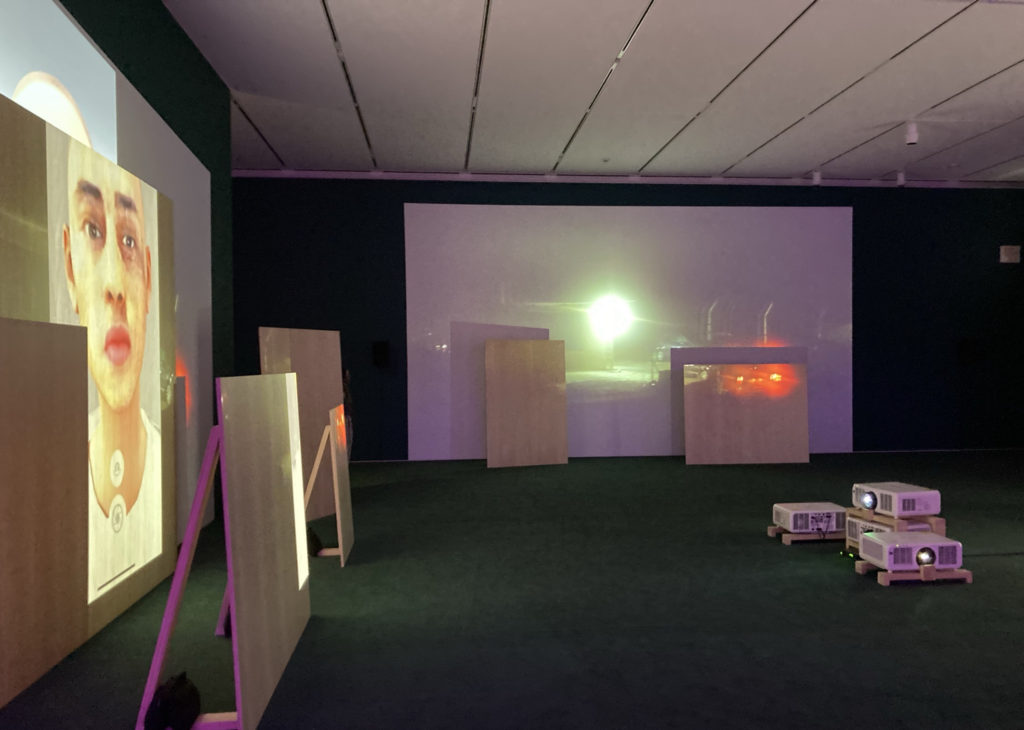
Even if At those terrifying frontiers were trying to make a point about the violence Palestinians can do to one another because of the occupation, that does not warrant presenting disability as a reduced state of being, which the video does, not only through presenting maimed Palestinians, but through text that repeatedly speaks from a place of wretchedness. It’s a wretchedness we all feel, but here, paired with scarring, it feels like a slight against the scarred and the maimed, or anyone who might not look the same as those who have been maimed. On the contrary, the Palestinian liberation movement is one that, at its best, is an environmental movement, a gender-equity movement, an abolitionist movement and a racial equality movement. It is also a movement for disability rights, especially when the Israeli occupation is a leading cause of Palestinian injury and disability.
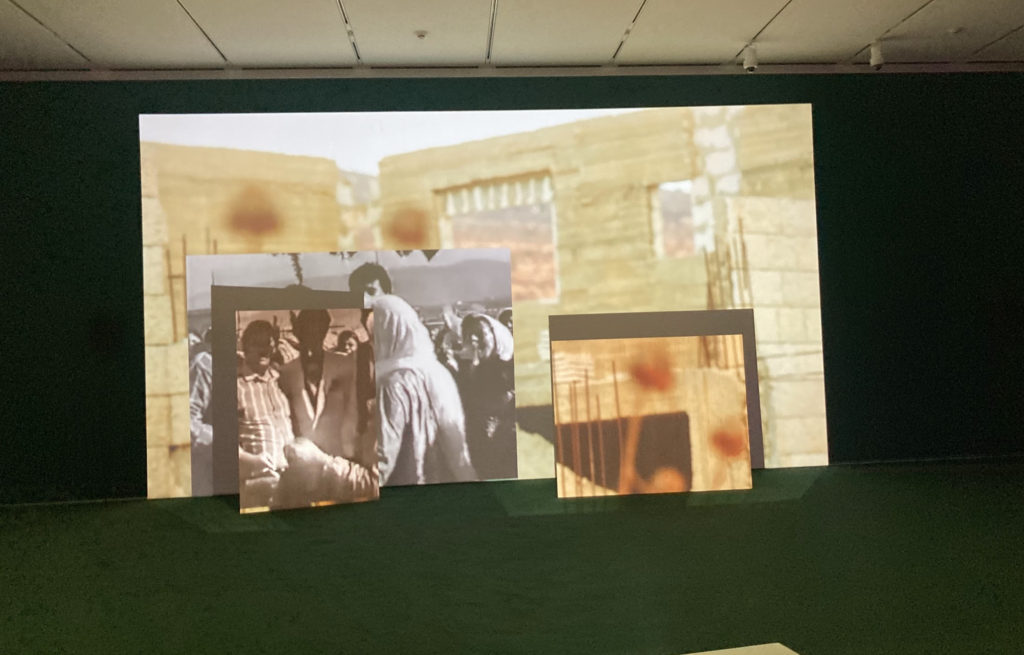
If I take a step back and consume the exhibition as a whole, I feel even more muddled and confused. The vinyls near the entrance –Don’t read poetics in these lines (2010–2021) and Once an artist, now just a tool (2021)– are mostly platitudes; things Palestinians know by nature of existing under the occupation but that perhaps need to be said in a museum. The vinyls are here because museums are launching surface-level ‘decolonizing’ schemes that are really aimed at re-colonizing; that’s why Once an artist, now just a tool was commissioned by the Art Institute itself. But Oh shining star testify is layered. The ten minute video tells the story of a young Palestinian man who was murdered by the Israeli military when out foraging for greens, layered in with security footage, historical film and crisp shots of Palestinian foliage. It splices together Palestinian footage to condemn this loss of life. The boy’s own funeral is intimated at, but with little reference in the label or the video itself; it’s the sort of reference someone who’s been to funerary gatherings in Palestine will understand, but perhaps not many others from outside of our cultures. I feel like Oh shining star testify is winking at me, if winks were melancholy, not predominantly cheeky. It is a message to Palestinians that our lives are rich, despite the threat of erasure, of murder. It reminds me of foraging with my parents, of that mundane fear that struck into my heart whenever faced with the occupation head-on. I love the piece.
The vinyls are here because museums are launching surface-level ‘decolonizing’ schemes that are really aimed at re-colonizing; that’s why “Once an artist, now just a tool” was added to the Art Institute’s permanent collection.
But Oh shining star testify ends, and less than half a minute later, At those terrifying frontiers starts again.
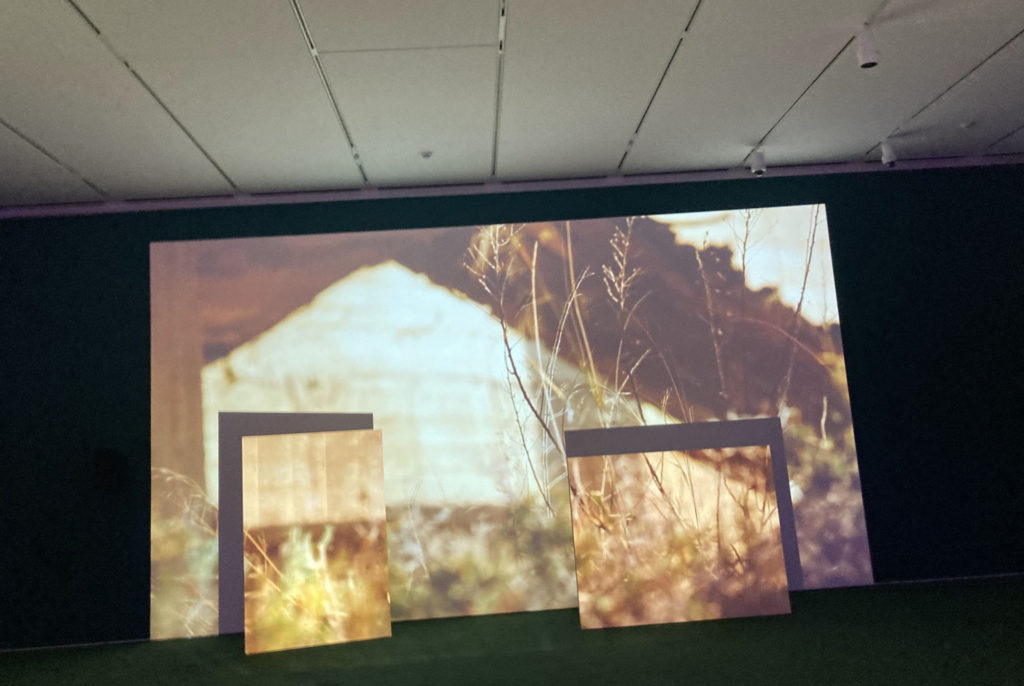
When I put it all together, maybe If only this mountain is trying to play to multiple audiences. But it’s hard for this Palestinian to leave the space feeling anything other than desolate and hurt. On the train ride home from the exhibition, I found myself scrolling through legendary Palestinian artist Sliman Mansour’s Instagram page, while listening to Shaykh Jarrah’s Bashar Murad’s latest EP. In Mansour’s art –like Wafa Hourani’s– I see Palestinians who look like my family and friends; in Murad’s Maskhara, I feel my own frustration, played out against a strong beat. This was a moment of healing and community, before I flicked to Twitter and its roar of news from Palestine, Sudan, Afghanistan and Tigray.
*Disclaimer: This piece was originally written for another outlet but when that publication refused to publish it over a technicality unrelated to the text of this piece, it came to Hazine, which was already planning to begin a run of exhibition reviews, which you’ll see over the next few months. That technicality at the other publication is a standard that excludes many groups of people from writing for that publication and we will try to be as accommodating as we can with our writers, prioritizing them, their labor and their safety. We hope they genuinely learn from their experiences with writers in the future.
N.A. Mansour is a historian of books, art and religion. She produces podcasts, edits Hazine.info, and works for different museums and archives. She also writes for the general public on culture, Islam and history, with publications in Contingent, Eater, The Counter and more.
1 The Palestinians in the other video art piece Oh shining star testify are only represented in historical footage or in part: an arm here, a leg here.

